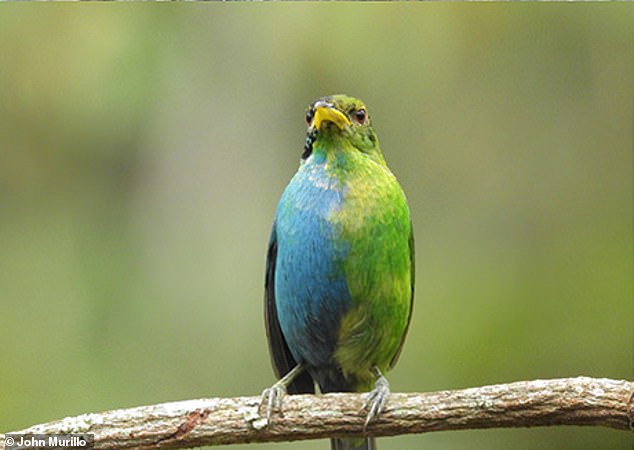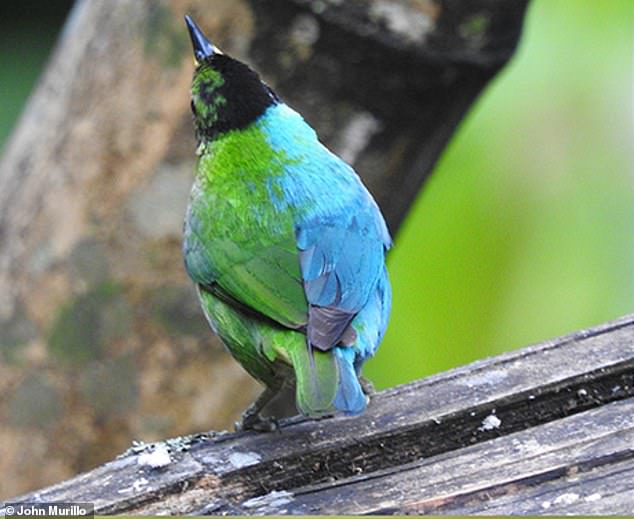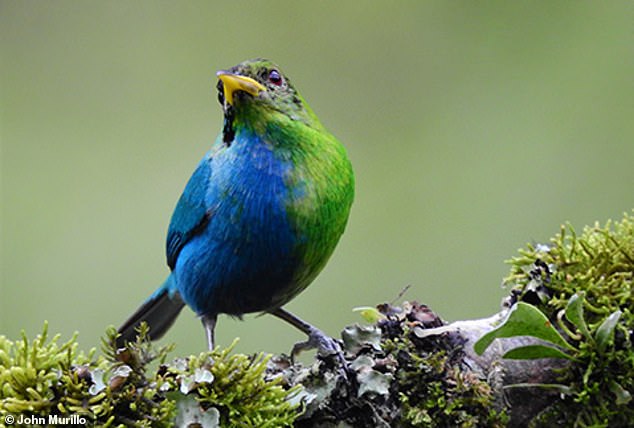Peck of the bunch! Mutant bird ‘that’s half male and half female’ is photographed in Colombia – in one-in-100-year event
An extremely rare 'mutant' bird, half male and half female, has been discovered in Colombia.
Scientists have revealed that the bird, whose feathers are half green and the other blue, has both male and female characteristics.
The mutant honeycreeper was spotted by an amateur birdwatcher last year, who took a photo and shared it with researchers at the University of Otago in New Zealand.
The team finally concluded that the amazing and unique feathers are due to the existence of two sexes, females in green, and males in blue.
Biologist Hamish Spencer, who was visiting Colombia on vacation, was fascinated by the sight, noting that this was the first observation made in more than a hundred years by any green honeycatcher.
Female green honeycreepers are usually green, and males are generally aqua blue. The dual coloration of this bird led scientists to conclude that it is a male and a female
“It's absolutely amazing, it was a pleasure to see it,” he said in an interview. statement.
As if its colors didn't make it unique enough, Spencer and his colleagues suspected that the bird was also half male and half female.
The color of females of this species is usually green, while males tend to be aqua blue.
So, since the bird was half of each color, it stands to reason that the colors correspond to the sex.
The team said the bird is a special example of bilateral gynandromorphy – the male on one side and the female on the other.
Gynandromorphism is often seen in arthropods, including lobsters, crabs, spiders, and insects.

Gynandromorphism is very rare in birds, and much rarer than in insects or crustaceans. This specimen is the second gynandromorph green honeybug ever reported.
But it has been reported occasionally in birds, specifically in sexually dimorphic birds – those species whose males and females look very different from each other.
“In birds, this phenomenon is thought to arise as a result of an error during meiosis of the egg, with subsequent double fertilization by separate sperm,” Spencer and his colleagues wrote in their paper on the bird, published in the latest issue of Nature. Journal of Field Ornithology.
As a result, one side of the bird contains female cells, and the other side contains male cells.

Scientists suspect that this bird could be a young male, due to the patchy pattern of its head feathers. But it was observed for about two years, long enough for the bird to grow into adulthood
“Many bird watchers can go their entire lives without seeing a bilateral gynandromorph in any bird species,” Spencer said in the statement. “This phenomenon is extremely rare in birds, and I know of no examples from New Zealand at all.”
In fact, this bird was only the second example of a gynandromorphic honeycreeper described in the scientific literature.
The first, described over 100 years ago, was also half blue and half green but on opposite sides of this.
“This particular example of bilateral gynandromorphy – male on one side and female on the other – demonstrates that, as in many other species, either side of the bird can be male or female,” Spencer said.
The scientists explained that the new bird's color split was not exactly 50-50, but they were still confident that the bird was a gynandromorph.

This gynandromorphic reptile was seen feeding on fruit left by the property owner
In fact, the patterns on its head could be considered “a little reminiscent” of those seen on a young honeycreeper.
But that doubt was dispelled by one big piece of evidence: his reddish-brown irises were a sign that he was an adult.
In addition, the plumage of male green honeycreepers does not moult in a half-and-half pattern, and this particular bird was observed for 21 months, a period much longer than the juvenile stage in this species.
Although the bird appeared to behave like other green honeybirds in the area, it may have had trouble occupying a role in the bird community: it would often wait until other honeybirds had left before feeding on fruit left by the property owner.
(tags for translation) Daily Mail
